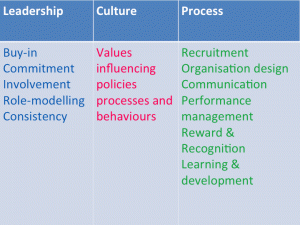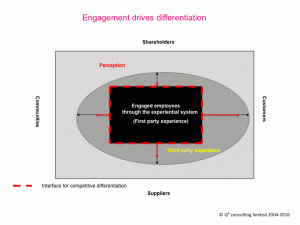As we now know, engaged employees tend to do the right things with enough frequency and in the right way, that performance, however it is measured, is impacted positively. Strong performance, goal achievement and organisational success can all be results of an engagement focus. While this will help the organisation develop year over year, how can this be utilised to create competitive advantage?
The traditional battleground for seeking an advantage over the competition includes the products and services an organization produces, in terms of design, function and quality; pricing; distribution; marketing and advertising; IT systems; and support. Advantage gained in this way is only sustainable if the cost of entry is too high for aspiring competitors. The problem is that most of these differentiating attributes can be copied or acquired. The time lag between innovation and imitation can now be measured in weeks rather than years. So where does sustainable competitive advantage come from?
According to Terry R. Bacon, writing in the Lore International Institute White Paper Series in 2002, organisations should differentiate through behaviour. Calling this process Behavioural Differentiation, Bacon (2002) explains,
“Behavioural differentiation is difficult to copy because it requires more skill and will than many companies have—even when they know what they are doing. There is a huge gap between knowing how to behave and behaving that way consistently”.
Working alongside other attributes of the organisation, these behaviours have to be perceived as differentiating. They could be unique to your organisation, or you may just be much better at them than competitors. Customers will see this, and if they perceive value in these behaviours, they will enhance the customer experience.
There are, Bacon says, four key differentiating behaviours:
- Operational behaviours: These reflect the way the business operates; they are standard operating procedures (SOPs) if you like. While most will be transactional, they are constructed with differentiation from competitors in mind. This is an example of state engagement.
- Interpersonal behaviour: This is about the way staff interacts personally with customers; therefore, it has more to do with the attitude and personality of these people rather than something that can be operationalised. Recruiting the right people for these roles is critical, as is reinforcing and rewarding the desired behaviours. Customers can see through the inauthentic, “Have a nice day” approach. This is trait engagement at work.
- Exceptional behaviour: This is people taking on extra-role responsibilities to work in the customer’s interest and exceed their expectations. It is important, therefore, that staff feel they have the freedom to work on their initiative, even outside standard operating procedures, if it benefits the customer and enhances the image and reputation of the business. This is behavioural engagement.
- Symbolic behaviour: These behaviours reflect and endorse your key product and service offerings. Your organisation is walking the talk and ensuring that there are clear linkages between the rhetoric of its marketing and the reality of dealing with it.
While in Bacon’s work the focus is on external customer relationships, there is no reason why in an engaged workforce these principles do not apply internally with colleagues and externally with suppliers and other communities of interest. An article by Harter et al in the Harvard Business Review (2002) found that customer and employee engagement augment each other at the local level, creating an opportunity for accelerated improvement and growth of overall financial performance. Analysis of the performance of 1,979 business units in 10 companies revealed that those units that scored above the median on both employee and customer engagement were on average 3.4 times more effective financially (in terms of total sales and revenue performance to target, and year over year gain in sales and revenue) than units in the bottom half of both measures.
For this approach to work, three key components must be present: leadership, culture and process. Leadership must be fully invested, involved in and committed to the process. Leaders have to model the desired behaviours consistently and encourage others to do the same, thus giving people a degree of flexibility in expressing themselves as they master new ways of working. Culturally, the core purpose and core values must influence the key operational processes and desired behavioural outcomes; this must be further enhanced and supported by the organisation structure and people management policies and processes, including recruitment and induction, organisation design, communication, performance management, total rewards, and learning and development.
What you create inside the organisation will have a positive impact outside the organisation. The employment experience conditions the desired behaviours to the benefit of customers, suppliers and, to a lesser but still important extent, communities and shareholders. The first-party experience influences the third-party experience at the point of contact. That intersection is the source of sustainable competitive advantage; thus, how your external stakeholders experience your organisation through your people is critical.

